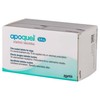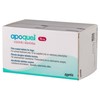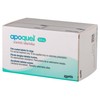Apoquel
Apoquel Tablets are indicated for the control of itching associated with allergic dermatitis and control of atopic dermatitis in dogs at least 12 months in age. Developed to work differently than other treatments for allergic dog itch, Apoquel goes right to the source to stop the underlying cause; targeting specific small proteins involved in dog allergies that cause itching and inflammation.
Apoquel Tablets are presented as small white tablets that are marked with AQ on one side, and S, M or L on the other side referring to the strength.
Apoquel 5.4mg Film Coated Tablets for Dogs
£1.02Apoquel 5.4mg Tablets are for the treatment of pruritus associated with allergic dermatitis, and the treatment of clinical manifestations of atopic dermatitis in dogs. Apoquel starts...[More info]
Apoquel 16mg Film Coated Tablets for Dogs
£1.92Apoquel 16mg Tablets are for the treatment of pruritus associated with allergic dermatitis, and the treatment of clinical manifestations of atopic dermatitis in dogs. Apoquel starts...[More info]
Apoquel 3.6mg Film Coated Tablets for Dogs
£1.02Apoquel 3.6mg Tablets are for the treatment of pruritus associated with allergic dermatitis, and the treatment of clinical manifestations of atopic dermatitis in dogs. Apoquel starts...[More info]
Dosage and administration
For oral use.
Dosage and treatment schedule
The recommended initial dose is 0.4 to 0.6 mg oclacitinib/kg bodyweight, administered orally, twice daily for up to 14 days.
For maintenance therapy, the same dose (0.4 to 0.6 mg oclacitinib/kg bodyweight) should then be administered only once a day. The requirement for long-term maintenance therapy should be based on an individual benefit-risk assessment.
Apoquel can be administered with or without food.
Contra-indications, warnings, etc
Do not use in cases of hypersensitivity to the active substance or to any of the excipients.
Do not use in dogs less than 12 months of age or less than 3 kg bodyweight.
Do not use in dogs with evidence of immune suppression, such as hyperadrenocorticism, or with evidence of progressive malignant neoplasia as the active substance has not been evaluated in these cases.
The safety of Apoquel during pregnancy, lactation or in dogs intended for breeding has not been established, so its use is not recommended.
Oclacitinib modulates the immune system and may increase susceptibility to infection and exacerbate neoplastic conditions. Dogs receiving Apoquel tablets should therefore be monitored periodically with complete blood counts and serum biochemistry when on long-term treatment.
When treating pruritus associated with allergic dermatitis with oclacitinib, investigate and treat any underlying causes (e.g. flea allergic dermatitis, contact dermatitis, food hypersensitivity). Furthermore, in cases of allergic dermatitis and atopic dermatitis, it is recommended to investigate and treat complicating factors, such as bacterial, fungal or parasitic infections/infestations (e.g. flea and mange).
After day 16, the following adverse reactions have been observed:
•pyoderma and non-specified dermal lumps have been observed very commonly;
•otitis, vomiting, diarrhoea, histiocytoma, cystitis, yeast skin infections, pododermatitis, lipoma, polydipsia, lymphadenopathy, nausea, increased appetite and aggression have been observed commonly.
The frequency of adverse reactions is defined using the following convention:
•very common (more than 1 in 10 animals treated displaying adverse reaction(s))
•common (more than 1 but less than 10 animals in 100 animals treated)
•uncommon (more than 1 but less than 10 animals in 1,000 animals treated)
•rare (more than 1 but less than 10 animals in 10,000 animals treated)
•very rare (less than 1 animal in 10,000 animals treated, including isolated reports).
Treatment related clinical pathology changes were restricted to an increase in mean serum cholesterol and a decrease in mean leukocyte count, however, all mean values remained within the laboratory reference range. The decrease in mean leukocyte count observed in oclacitinib-treated dogs was not progressive, and affected all white blood cell counts (neutrophil, eosinophil and monocyte counts) except lymphocyte counts. Neither of these clinical pathology changes appeared clinically significant.
The development of papillomas was noted in a number of dogs in a laboratory study.
Anaemia and lymphoma have been reported very rarely in spontaneous reports.
No drug interactions were observed in field studies where oclacitinib was administered concomitantly with veterinary medicinal products such as endo- and ectoparasiticides, antimicrobials and anti-inflammatories.
The impact of oclacitinib administration on vaccination with modified live vaccines, canine parvovirus (CPV), canine distemper virus (CDV) and canine parainfluenza (CPI) and inactivated rabies vaccine (RV), on 16 week old vaccine naïve puppies has been studied. An adequate immune response (serology) to CDV and CPV vaccination was achieved when puppies were administered oclacitinib at 1.8 mg/kg bodyweight twice daily for 84 days. However, the findings of this study indicated a reduction in serological response to vaccination with CPI and RV in puppies being treated with oclacitinib compared to untreated controls. The clinical relevance of these observed effects for animals vaccinated while being administered oclacitinib (in accordance with the recommended dosing regimen) is unclear.
Oclacitinib tablets were administered at 1x, 3x and 5x to healthy, one year old Beagle dogs twice daily for 6 weeks followed by once daily for 20 weeks.
Clinical observations that were considered likely to be related to oclacitinib treatment included: alopecia (local), papilloma, dermatitis, erythema, abrasions and scabbing/crusts, interdigital "cysts", and oedema of the paws. Dermatitis lesions were mostly secondary to the development of interdigital furunculosis on one or more paws during the study, with the number and frequency of observations increased with increasing dose. Lymphadenopathy of peripheral nodes was noted in all groups, increasing in frequency with increased dose, and was frequently associated with interdigital furunculosis. Papilloma was considered treatment related, but not dose related.
There is no specific antidote and in case of signs of overdose the dog should be treated symptomatically.
User warnings
Wash hands after administration.
In case of accidental ingestion, seek medical advice immediately and show the package leaflet or label to the doctor.
Further information
Oclacitinib is a Janus kinase (JAK) inhibitor. It can inhibit the function of a variety of cytokines dependent on JAK enzyme activity. For oclacitinib, the target cytokines are those that are proinflammatory or have a role in allergic responses/pruritis.
Following oral administration in dogs, oclacitinib maleate is rapidly and well absorbed, with a time to peak plasma concentration (tmax) of less than 1 hour. The absolute bioavailability of oclacitinib maleate was 89%.
Total body oclacitinib clearance from plasma was low; 316 ml/h/kg bodyweight (5.3 ml/min/kg bodyweight), and the apparent volume of distribution at steady-state was 942 ml/kg bodyweight. Following intravenous and oral administration, the half-lives were similar at 3.5 and 4.1 hours respectively. Oclacitinib exhibits low protein binding.
Overall the major clearance route is metabolism, with minor contributions from renal and biliary elimination. Inhibition of canine cytochrome P450s is minimal. Therefore, the risk of metabolic drug-drug interactions due to oclacitinib inhibition is very low. No accumulation was observed in the blood of dogs treated for 6 months with oclacitinib.


